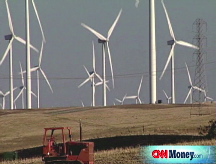SACRAMENTO, Calif. -- California air regulators adopted a sweeping new climate plan Thursday that would require the state's utilities, refineries and large factories to transform their operations to cut greenhouse gas emissions.
The California Air Resources Board voted unanimously to adopt the nation's most comprehensive global warming plan, outlining for the first time how individuals and businesses would meet a landmark 2006 law that made the state a leader on global climate change.
The plan would hold California's worst polluters accountable for the heat-trapping emissions they produce _ transforming how people travel, how utilities generate power and how businesses use electricity.
At the heart of the plan is the creation of a carbon-credit market designed to give the state's major polluters cheaper ways to cut the amount of their emissions. That market and the many other strategies referenced in the plan will be fleshed out and adopted over the next few years.
California's plan comes at a time when governments around the world are struggling with a financial crisis that threatens to undermine efforts to fight climate change. California itself is facing a forecast budget gap of $41.8 billion through June 2010.
Republican Gov. Arnold Schwarzenegger, who has said the state's climate law will stimulate the economy, said Thursday that California was providing a roadmap for the rest of the country.
"Today is the day we help unleash the full force of California's innovation and technology for a healthier planet, a stronger and more robust economy and a safer and more secure energy future," Schwarzenegger said in a statement released after the board's vote.
His sentiments echo those of President-elect Barack Obama, who also has promoted investments in energy efficiency and green technology to help spur the country out of recession. Last month, Obama said he hoped Congress would adopt California's targets for the entire country, essentially reversing eight years of U.S. policy against mandated emission cuts.
California's 2006 law, called the Global Warming Solutions Act but commonly referred to as AB32, mandates the state cut emissions to 1990 levels by 2020.
The strategy chosen by air regulators relies on 31 new rules affecting all facets of life, from the fuels Californians put in their vehicles to the air conditioners businesses install in their buildings.
The average Californian, for example, could see more fuel-efficient cars at dealerships, better public transportation, housing near schools and businesses and utility rebates to equip their homes to be more energy efficient.
But there will also be costs.
'US News' 카테고리의 다른 글
| Five festive Christmas stores (0) | 2008.12.14 |
|---|---|
| Bush declares emergency in icy Massachusetts (0) | 2008.12.14 |
| Anderson Cooper free dives with great white sharks in South Africa (0) | 2008.12.12 |
| Fed: household debt, net worth post declines (0) | 2008.12.12 |
| New unemployment claims surge unexpectedly (0) | 2008.12.12 |




